When your marijuana plants grow outdoors, the seasons and the changing position of the sun has an impact on their growth. Based on the changing position of the sun, the life cycle of the plant is altered and when sunlight hours are naturally reduced, the plants enter a flowering phase. This is why mid to late summers are the best time to grow these plants as this means that they would naturally enter the flowering phase as light hours start getting reduced in winter months. When you grow indoors, you are no longer dependent on the sun and its natural cycle – and you can grow your plants under ideal lighting conditions year-round. Dimming your lights plays a major role in this – and in this article, we shall be providing a detailed look at dimming your ballasts.
“Should I dim my Ballast?” this is one of the most common and frequently asked questions that we get from many of our readers. This comes especially from those who are new to growing, and sometimes even from the experienced ones. This is an important question and we believe it needs to be answered in great detail and hence we have come up with an entire article on this. Dimming your lights the wrong way might be detrimental to the health of the grow lights! We shall explain that in detail here.
In this article, let us first take a closer look at what ballasts are and what role they play in your grow lights. Post that, let us understand the concept of dimming – when and why should you dim your lights, and most importantly, how should you dim your ballasts. There are many myths associated with dimming and many growers tend to do it the wrong way. The idea behind this article is to bust all these myths and misconceptions and to show you the right way in which you should use your dimmers so that your light lasts for a long time and your plants also get a better growing experience.
What Are Grow Light Ballasts?
Before we get involved with the whole dimming business and understand how and why you should dim your ballasts, let us first understand what grow light ballasts truly are and the role that they play in your grow light. We will also look at the different kinds of grow light ballasts in this section.
A ballast is needed in every sort of a grow light – it is most obvious in the case of HID lights (HPS grow lights and Metal Halides), but even fluorescent grow lights and LED grow lights come with built-in ballasts which may or may not be obviously visible. In case of HID grow lights, the ballasts comes separately.
In the simplest of terms, the function of a ballast is to regulate the flow of current in the grow light. When HID lights are starting off, they require a high current inflow so that they can power through and that the chemicals inside them can vaporize. However, once that is achieved, the flow needs to be reduced and stabilized otherwise an excess here might lead to the bulb exploding. This is where the ballast is important as it makes sure something like this does not happen.
Another thing that you need to know about High-Intensity Discharge grow lights is that as they tend to age, these lights require more current to perform at a similar level as they would in the past. Ballasts make sure that more current is provided to these lights at that point in time to keep their performance intact. The ballasts also acts as a circuit breaker – in case your light needs too much current, it will automatically cut off the supply and shut it off. You will know your light has reached such a stage by turning it on again – but the ballast will automatically cut it off and turn it off again. This means you now need a new grow light.
All of this put together proves why ballasts are important for grow lights. Let us now take a closer look at the two major types of ballasts in the markets:
Electronic Ballasts vs Magnetic Ballasts
There are, largely speaking, two types of grow light ballasts: the first of these are electronic ballasts and the second type is a magnetic ballasts. The latter is older and less preferred these days while electronic ballasts are considered newer (and even have an upgraded version called digital ballasts). Inside a magnetic ballast, there is a large wire wrapped around sheets of steel. They are quite thick and heavy, and also tend to generate quite a bit of heat – all of these together explain why these ballasts are no longer as popular as they used to be. However, on the bright side, all magnetic ballasts are created in accordance with American National Standards Institute’s standards. This makes sure that they work very well with the lights that support them.
On the other hand are the modern kind of ballasts – the electronic ones. These have been around for quite some time too and are considered more popular among today’s growers. Electronic ballasts don’t have a magnetic coil inside them like a magnetic ballast. Instead, they carry semiconductors and microchips which control the flow of current in a smarter way. These are less bulky in appearance and do not generate as much heat. Moreover, these ballasts are considered safer by most growers. However, the one difference here is again about the ANSI standards – each brand makes their electronic ballast differently and bulb performance might be affected unless you buy bulbs and ballasts of the same brand (which is why many people prefer buying grow light kits where ballasts and bulbs come together).
Over the years there has also been a third kind of a ballast that has emerged but it is not entirely different from an electronic ballast. These are Digital Ballasts and the only major difference here is that they carry inside them a microprocessor and look much more like a computer on the inside than what you would expect a ballast to look like. There are many sellers who sell regular electronic ballasts under the name ‘digital ballast’ so make sure you check if the ballast you are buying actually has a microprocessor in it or not!
Dimming Your Ballast: What is Dimming?
Coming down to the whole dimming aspect of it, when you talk about dimmable ballasts you are usually talking about electronic (or in some cases, digital) ballasts. Magnetic ballasts are usually not seen as dimmable. The function of a dimmable ballast is that it allows you to increase or decrease the intensity of the light that is coming out of your bulb. The more the current flows inside the bulb, the higher the brightness – however, an excessive amount of current can lead your light to blow up. Similarly, the lesser the flow of current inside the light, the dimmer the lighting. A dimmable ballasts allows you to regulate the flow of current in and out of your grow light in a manner that you could dim and brighten up the light based on your needs.
Imagine you have a 1000W grow light – a dimmable ballast would come with settings that allow you to control the flow of current to 300W, 600W, 900W, and in some cases, even 1100W. However, most modern-day ballasts don’t give you the readings but instead show you ranges like 25%, 50%, and 75% instead – and you need to make the calculations by yourself.
-
Why Should You Dim Your Ballasts?
Growers tend to dim their lights because of different reasons. Sometimes, it is because they want to provide the ‘evening’ effect to their plants. Under the natural circumstances, the sunlight begins to dim out before it goes out completely. Such an effect can be created on indoor plants by having a timer dim the lights at a particular time before completely turning them off. In some rare cases, if growers feel that the light is too intense for their plants but they don’t want to move it up, they would rather dim them down. This would also help reduce the heat that comes from these grow lights. Similarly, growers who use full-spectrum lights that offer vegging and growing under the same lighting usually like to use the lights at full-brightness during the vegetative phase and lesser brightness during the flowering stages.
Dimming your lights is particularly useful for growers who live in hot places during summer months because the heat can be a little too much for your plants. Furthermore, another use of dimming your ballasts is to reduce the coverage area – this is done in the rare case of you having a grow light which covers a larger area than what your plants are spread in. Doing so will help you crop down the overall lighting area and focus it only on your plants, while also saving you quite a bit of money. Lastly, you must also dim if your plants have grown too tall and there’s no space for the light to move further up. Not dimming the light in that case might lead to damaging your plants.
-
How Does Dimming Work?
As explained above, dimming is a feature of the ballast. The ballast regulates how much current should flow into the grow light at any given point of time and that is quite important to ensure the light provides the right kind of light for the long term – and that there is a control over how much current flows inside the bulb. If there’s a surge and too much current goes in this might lead to excessive brightness and eventually an explosion in the bulb. While you cannot exceed the maximum possible wattage, you can actually reduce it and bring it back to the full capacity. This is how dimming works, as you reduce the wattage based on the needs of your plants at the moment. A 1000W grow light can down to about 400W, 600W or 800W depending on your needs.
Should I Dim My Ballast?
The answer to this question is – only if very important and extremely necessary. Most growers want to buy dimmable grow lights but they do not understand that dimming is not good for the health of your grow light. Dimming your ballasts should not be made a regular practice but it should be a last resort for when you have nothing else going right for your plants. Dimming should be used in the rare case that your plants have overgrown and are getting too close to the light, or if you are in a hot region where the temperatures are too high and the grow light might be damaging your plants. Dimming, in practically all other senses, might not be as useful.
Dimming your ballasts below the rated power of the bulb might actually lead to a decrease in the efficiency and the performance of the bulbs. The light output per watt (PPF) is severely affected when growers dim their grow lights. A 1000W grow light operating at 1000W is way more efficient over the long term than a 1000W grow light operating at about 750W. Running your bulb at full power and maximum rated brightness is the best way to use a grow light. Unless, of course, the situation really demands a major change in your wattage.
Another disadvantage of dimming your grow lights comes when you look at the spectrum. The lighting spectrum changes by quite a bit if you choose to dim down your grow light. It is ok if you are using just one or two lights, but for commercial-scale growers, the impact of this change in the spectrum might be quite a bit as there are a large number of grow lights and a large number of plants involved, and any the impact of any change will be seen on a magnified scale.
One more thing that you need to know, especially if you are using HID grow lights and dimming them – is that you must never attempt to dim your grow light before at least about a hundred hours of them being operational. By that point, the lights have stabilized chemically and the chances of ignition failures are much lesser. Dimming your grow lights early on always has a negative impact on the overall lifespan of your grow light. Most grow lights come with an instruction manual – and you must read it before you start dimming your lights. This will ensure that you are using the manufacturer-prescribed way of dimming and your lights are not getting any damage at all!
-
Should I Boost My Ballasts?
There are two sides to dimming your ballasts – you can either reduce the intensity, or you can increase it! When it comes to increasing the intensity, you must do it carefully and you must ensure that you are doing so with care. The one basic thing that you must know about increasing the intensity of your lights is that it is indeed going to have a negative impact on your lights at some point in time. However, since the lifespan of most HID lights is close to a couple of years and most growers change these lights almost on a yearly basis, boosting is something that growers tend to prefer. Ideally you shouldn’t boost too much, but if you do, its ok as long as you are following the manual provided by your manufacturer.
Dimming LED Grow Lights
When it comes to grow lights, LED lights tend to hold quite a high position. This is because these grow lights are among the best in the business and tend to last much longer compared to any other grow light. Compared to HID lights which are usually replaced every couple of years, these lights can last for up to 100,000 hours (or even more in some cases) – which is beyond a decade! Furthermore, these lights consume the least energy and provide the most output. There are no chemicals inside LED grow lights too and hence they are easier to dispose. LED grow lights can be dimmed easily and without any problem as compared to HID lights and you can dim them for as long as you want without it really affecting the performance. Since there are no energy flow issues, and neither are there chemicals inside it – there are not restrictions on dimming these grow lights!
Things To Keep in Mind While Dimming Your Grow Light Ballasts
Lastly, before we head towards the conclusion, let us take a quick look at some key highlights which you need to keep in mind while dimming your ballasts:
1. Do not change the wattage too frequently
Frequent changing of the wattage has a negative impact on the overall lifespan of the grow light. Select a wattage you want to dim the light to and then let it be there till you want another intensity. Don’t change it too frequently so that the light can perform smoothly.
2. Do not dim your grow lights for the first hundred hours
The first hundred or so hours are quite critical for your HPS and MH grow lights. You need to allow the chemicals inside these grow lights to stabilize and only then should you go for dimming. This is another trick that can help you extend the lifespan of your grow light.
3. Try and dim only when absolutely necessary
As mentioned above, this is very important to understand. Dim only when needed – dim only when absolutely needed! Dimming HID lights must only be done when it is unavoidable and you are left with no other option but to dim your ballast.
4. Always follow the instructions from the manufacturer
This is always the safe route to take. Nobody knows your grow light better than the company who made it. Make sure you follow their manual to the T and dim your lights only in the way they prescribe it.
Frequently Asked Questions About Dimmable Grow Lights
Here are the answers to some of the most common and frequently asked questions about dimmable grow light ballasts:
1. How do ballasts prevent my lights from exploding?
The higher amount of current that passes through the arc of the HPS/MH lights, the brighter they tend to glow. However, after one point if you keep passing too much current there might be an explosion inside the bulb as the gases will begin to react to the heat in a manner they shouldn’t be. A ballast can sense when to stop providing current to a grow light and it can therefore save explosions from happening.
2. Are all ballasts dimmable?
No, all ballasts are not dimmable. When you are buying a new grow light ballast, check whether the manufacturer has specified that the one you have chosen is a dimmable ballast or not. Electronic and Digital ballasts support dimming. Magnetic ballasts are generally not dimmable – this is another thing you must keep in mind when you buy ballasts for your grow lights.
3. Is it safe to dim LED lights?
Yes, it is absolutely safe to dim LED lights as much as you want and as many times as you want. There is no risk of hampering the lifespan or the performance of the grow lights when doing so on an LED grow light.
4. Why do most people not care about the impact of dimming on the lifespan of the light?
This attitude comes from the fact that most HPS grow lights and MH grow lights are usually changed by the growers every year or sometimes every season. Most of these lights have a short lifespan between 1-2 years and after half their lifespan their performance is anyway affected. Hence growers begin to boost or dim the lights as they please as they want to get the most out of their grow lights before they retire them and replace them for newer grow lights.
Conclusion
We hope that by this point in our article you have come to know everything that there is to know about dimmable ballasts and dimming your grow lights. Dimming (in cases of an HID grow light) should only be done when absolutely necessary – and the same is the case with boosting. We have provided you with a detailed list of when to dim and how to dim your grow lights and ballasts and following that would ensure that you are getting the best possible benefit out of your grow lights! If there are still any more questions or doubts, feel free to mail us or let us know over the comments section and we shall get back to you soon! Till then…
…Happy Growing! 🙂
Table of Contents


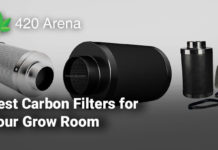
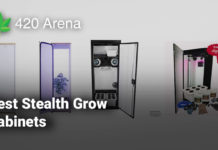





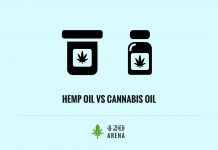



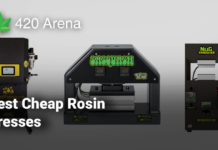

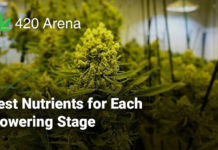
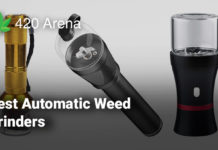
![How to Use Carbon Filters in Your Grow Room [7 Best Carbon Filters for Grow Rooms in 2021] How to Use Carbon Filters in Your Grow Room](https://420arena.com/wp-content/uploads/2020/12/How-to-Use-Carbon-Filters-in-Your-Grow-Room-218x150.jpg)










